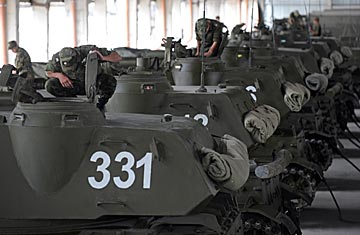
Russian soldiers prepare tanks at the Tskhinvali military base on Aug. 7, 2009
Emerging from behind the cover of a tree and thick bushes, the blunt nose of a Russian eight-wheeled armored personnel carrier juts into the dirt road. In the shade, five soldiers — Special Forces and border guards — sit bored, smoking cigarettes near a burned-out campfire. A sixth lulls in the vehicle, blasting techno dance music. "We are prepared for the Georgians if they come. We don't think they'll start anything, but if they do, we're ready for them," says a border guard, standing in grimy fatigues with a worn Kalashnikov over his shoulder.
Ready, and waiting. Georgia and Russia have traded increasingly belligerent accusations against the other as the anniversary of last year's five-day war has approached in recent weeks; these soldiers, sent by Moscow to guard the breakaway republic of South Ossetia, are on the front line of that war of words. A tour of towns north of the border shows just dependent South Ossetians are on the Russians, and how much this small region, ostensibly independent, has actually become a de facto Russian province.
Down a heavily potholed road, in some places splashed by mountain streams, the abandoned village of Eredvi comes into view. Populated by ethnic Georgians before the 2008 war, the village is now empty. Every house has been demolished and the villagers have all fled to Georgia. Plants grow between the heaps of bricks and stone. The school, which had been recently repaired before the war, today stands faded pink and windowless. Looters, whom locals claim do not exist, have stripped the place — even digging the wiring out of the walls. They have taken everything but the Georgian-language textbooks.
Teiran Bestayev, 50, a resident of the neighboring Ossetian village of Dmenisi is unrepentant. "Now we are over here and they are over there," he says, waving vaguely towards Gori, Georgia's second largest city, which lies just a few dozen miles to the south down the broad valley below. "They have Georgia and we have South Ossetia and that's how it should be."
Most people in this village of 1,000 ethnic Ossetians would probably agree. Before the war, says Bestayev, local villagers had to present passports and undergo searches when they traveled through Eredvi on the way to the South Ossetian capital Tskhinvali about six miles (9.7 km) away. "Maybe those idiots will start shooting again," he said, again motioning towards Georgia, "but that would be their last shot. Our side of the border is much stronger now."
This week the Russian Deputy Foreign Minister Grigory Karasin said the Kremlin would station around 3,000 troops in South Ossetia and Abkhazia by the end of the year. The Russian army has already built three bases in this scrubby mountain territory, and is building a fourth. Tskhinvali, which remains pockmarked and burnt from the five days of heavy fighting despite loans and pledges from Russia that the city would be rebuilt, is now host to a pristine Russian army base surrounded by high walls and barbed wire.
Inside, an a cappella version of "God Bless America" echoes over an empty concrete parade ground from a PA system. Long rows of mint green barracks recede down spotless, freshly laid concrete streets. A gigantic garage housing dozens of battle tanks, howitzers, armored personnel carriers and troop trucks has been constructed. Around the base, soldiers bearing tattoos sit or stand in long lines, breaking down and cleaning rifles and machine guns. "We are ready every day to fight if we have to. That's why we are here," says 20-year-old Corporal Sergey Ifankin, a member of the artillery.
But what the soldiers might have to fight is hard to pin down. Although claims abound of cross-border grenade and mortar attacks, Bestayev, the Ossetian villager from Dmenisi, said he had not heard or seen any incidents at the base of the foothills that mark the border. The soldiers sitting by their armored personnel carrier make a vague claim they had had mortars fired on them a week ago, but that the shots were uphill and off the mark. A lieutenant who has served six years in the border guards said he had not seen any attacks with his own eyes, but had heard many rumors.
The South Ossetian government claims the uptick in cross-border shooting is real and dangerous. "Practically every day, unfortunately, the Georgians are shooting into South Ossetia," says Alan Pliyev, the first deputy minister of the South Ossetian Ministry of Foreign Affairs. "They have been breaking the cease-fire organized by President Medvedev and French President Nicolas Sarkozy at the end of the war last year." Georgia has repeatedly denied shooting into South Ossetia and blames the Russian buildup for the rising tensions.
While acknowledging that the presence of international monitors could help to stabilize the situation here, Pliyev also says that his government is "working with and have an agreement with the Russian military for the defense of South Ossetia." In fact, observers from the European Union Monitoring Mission have been denied access to the South Ossetian side of the border to verify claims of attacks as well as to observe Russian troop increases. South Ossetia, nominally an independent state, is not going to make a move without Russia's consent. That's made clear by the 1,000 Russian troops bivouacked just outside the capital with more on the way. "It is certain that we want to be united with [Russian] North Ossetia, but we aren't sure how this will be carried out. But there is the prospect," says Pliyev.
